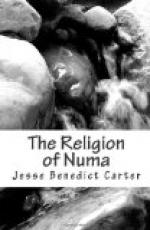Greece gave her gods to Rome when she herself was weary of them, she gave her the tired gods, exhausted by centuries of handling, long ago dragged down from Olympus, and weary with serving as lay-figures for poets and artists, and being for ever rigged out in new mythological garments, or jaded with the laboratory experiments of philosophers who tried to interpret them in every conceivable fashion or else to do away with them entirely. It is no wonder that it did not take the Romans more than a century to come to the end of these gods, to find that the only one among them who could satisfy their religious desires was the least Greek of them all, the Magna Mater, and having found this to go forth to take to themselves more like unto her, in a word, to crave the sensational cults of the Orient. And the philosophy which Greece gave Rome was no better than the mythology. It is not strange that human thought experienced a reaction after a century which contained both Plato and Aristotle, but it is a pity that Rome should have learned her philosophy from a period of doubt and scepticism, an age in which the lesser masters, who had known the greater ones, had gone, leaving nothing but pupils’ pupils.
The history of religion in Rome during the last two centuries of the republic is the story of the action and reaction of these two tendencies—the one toward the novel and sensational in worship, which we may call superstition, the other the philosophy of doubt, which we may call scepticism—in the presence of the established religion of the state. This much the two centuries have in common, but here their resemblance ends. In the first of these centuries (B.C. 200-100) the state religion was able to hold her own, at least in outward appearance, and to wage war against both tendencies. In the other century (B.C. 100 to Augustus) politics gained control of the state religion and so robbed her of her strength that she was crushed between the opposing forces of superstition and scepticism. It is to the story of the earlier of these two centuries, the second before Christ, that we now turn.




